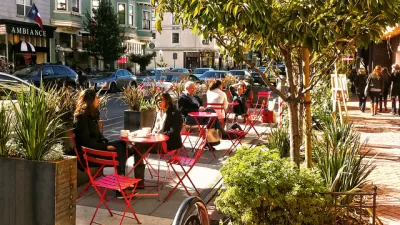Older, white homeowners take up far more than an equal share of the seats at the planning table in San Diego.

Andrew Keats shares news of new demographic analysis of the community planning groups that provide feedback on planning processes in San Diego, finding membership that trends whiter, older, and more affluent than the city as a whole.
Staff at the San Diego Planning Department conducted a first-of-its-kind survey to produce the results, which won't come as a surprise to the many advocates and observers who have spent decades pointing out the disparities in representation in planning processes.
"Nearly twice as many planning group members own a home as the city at large. The share of city residents between 20 and 29 is nearly five times greater than the share of planning group members. And white people make up nearly double the share of planning group members as they do San Diego residents," explains Keats more specifically about the findings of the survey.
The city is covered by 42 group elected boards, which represent specific geographic areas and review city planning decisions and private development proposals.
"Late last year, a City Council committee passed a series of reforms to the city’s planning groups," according to Keats. Though the Council adopted the policy outlining the groups in 1976, they’ve been under increasing scrutiny in recent years, with critical reports from the city auditor, county grand jury and a private housing advocacy group in 2018, and a legal memo from the city attorney last year that indicated the groups could be illegal as currently constituted.
In recent years, Portland, Oregon and Minneapolis have launched efforts to reform neighborhood planning organizations in response to similar disparities in those cities.
FULL STORY: Community Planning Groups Skew Richer, Whiter and Older

Planetizen Federal Action Tracker
A weekly monitor of how Trump’s orders and actions are impacting planners and planning in America.

San Francisco's School District Spent $105M To Build Affordable Housing for Teachers — And That's Just the Beginning
SFUSD joins a growing list of school districts using their land holdings to address housing affordability challenges faced by their own employees.

The Tiny, Adorable $7,000 Car Turning Japan Onto EVs
The single seat Mibot charges from a regular plug as quickly as an iPad, and is about half the price of an average EV.

With Protected Lanes, 460% More People Commute by Bike
For those needing more ammo, more data proving what we already knew is here.

In More Metros Than You’d Think, Suburbs are Now More Expensive Than the City
If you're moving to the burbs to save on square footage, data shows you should think again.

The States Losing Rural Delivery Rooms at an Alarming Pace
In some states, as few as 9% of rural hospitals still deliver babies. As a result, rising pre-term births, no adequate pre-term care and "harrowing" close calls are a growing reality.
Urban Design for Planners 1: Software Tools
This six-course series explores essential urban design concepts using open source software and equips planners with the tools they need to participate fully in the urban design process.
Planning for Universal Design
Learn the tools for implementing Universal Design in planning regulations.
Smith Gee Studio
City of Charlotte
City of Camden Redevelopment Agency
City of Astoria
Transportation Research & Education Center (TREC) at Portland State University
US High Speed Rail Association
City of Camden Redevelopment Agency
Municipality of Princeton (NJ)





























